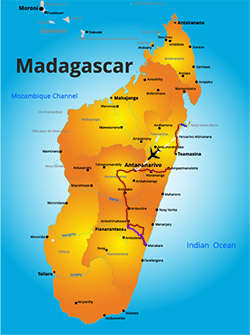Face to face with the Malagasy population and the lemurs
We will offer this tour in 2025 in an internationally mixed group eight times on the dates below (there can also be German-speaking participants, if there is a group of four or more Pax per date of which min. two are English-speaking participants, we will provide a German – and an English-speaking guide, except on Sainte Marie island)
Madagascar Photography Expedition 2021

EAST, WEST AND SOUTH Welcome to the “laboratory of evolution” another name for the Island of Madagascar.This Island is home to 160 endemic mammals, including 99 lemur species. 110 endemic bird species, 260 endemic reptiles, 60 endemic snakes (thankfully none of which are venomous) and 290 endemic amphibians, not to mention countless endemic insects and plants, and more chameleons than anywhere else on earth! Truly stunning, amazingly diverse, and largely unspoiled. It’s also endlessly photogenic and a wonderful setting for a photography workshop.




 Le Voyageur
Le Voyageur 